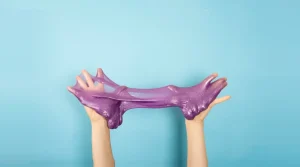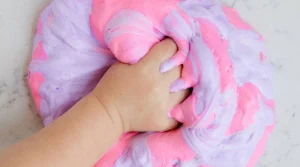
What Do Slime Toys Do? The Science and Learning Behind Slime
Curious about slime toys? Learn what they do and how they help children learn, create, and develop essential skills naturally.
#1 Toys Manufacturer in China. WhatsApp: +86 180-0088-4063. Email: [email protected]
#1 Toys Manufacturer in China. WhatsApp: +86 180-0088-4063. Email: [email protected]

If you’ve ever wondered why slime behaves the way it does, you’re in for a treat. Watery slime is one of the most intriguing types of slime out there—runny, smooth, and surprisingly scientific. It looks simple at first glance, but behind its gooey texture lies a world of chemical reactions, molecular structures, and sensory discovery.
In this article, we’ll unravel the mystery behind watery slime. You’ll learn about its viscosity, why it doesn’t behave like regular liquids, and how it’s used not just for play, but also for learning and development.
Watery slime looks like a puddle of goo. But don’t let its simple appearance fool you. It behaves in strange and surprising ways. It slips between fingers. It moves fast when pushed, slow when left alone. It’s not quite a liquid. Not quite solid.
Watery slime is a type of slime that has a thinner, more fluid texture than typical slimes. Instead of stretching or bouncing, it flows—much like syrup or melted jelly. It spreads out easily on flat surfaces and drips through gaps.
It belongs to a group of substances called non-Newtonian fluids. These fluids don’t follow the usual rules of liquids. When you poke watery slime, it resists. But when you let it rest, it slowly oozes again.
Some kids describe it as “melted slime” or “runny goo.” Scientists might call it shear-thinning or viscoelastic. Either way, its feel is different—and oddly satisfying.
Compared to classic slime, watery slime is much less thick. It doesn’t hold its shape. It slides. It doesn’t stretch like fluffy slime or click like butter slime. It lacks that dense, elastic feel.
You can think of it like comparing water to toothpaste. Both flow, but one does so much faster. Watery slime moves with gravity. Other slimes fight it.
Texture isn’t the only difference. Watery slime often dries out faster if left uncovered. It’s also more likely to leak through tiny cracks or holes in a container. That’s why it’s usually stored in sealed jars.
There’s even a sound difference. Watery slime is quieter. No popping or squishing sounds—just smooth, slippery silence.
Most watery slime starts with a simple base: water and polyvinyl alcohol (PVA) or glue. PVA is often found in white school glue, like Elmer’s. It helps the slime hold together.
Then comes a cross-linker—usually borate ions from borax or saline solution. These bonds give the slime its gel-like body, even if it’s loose and runny.
To keep it smooth and flowy, less thickener is added. Sometimes, glycerin or cornstarch is used in tiny amounts to adjust the consistency. A few drops of food coloring or mica powder give it a fun look.
No foam. No beads. No clay. Those ingredients would thicken it. Watery slime avoids them to keep its signature slippery feel.
Watery slime may seem like simple fun, but behind the slippery texture lies a world of science. Its movement, shape, and feel are all controlled by tiny particles and how they behave together. To understand watery slime, we need to zoom in—down to the level of molecules and forces.
Viscosity is a way to measure how thick or thin a liquid is. Water has low viscosity—it flows fast. Honey has high viscosity—it flows slow. Watery slime sits somewhere in between, but it doesn’t behave like normal liquids.
That’s because watery slime is a non-Newtonian fluid. Its viscosity changes depending on how you handle it. If you stir it slowly, it moves easily. But if you poke it fast, it resists.
This happens because the particles inside watery slime temporarily connect and disconnect. When left alone, they slide past each other. When disturbed, they tangle up.
Ketchup, toothpaste, and oobleck are also non-Newtonian. Watery slime is part of this curious group—strange, but scientifically sound.
Inside watery slime are polymer chains—long, repeating molecules. Think of them like cooked spaghetti. In thicker slime, these chains are tightly linked. In watery slime, there are fewer links, and more space between the strands.
This loose network is what makes watery slime flow so easily. The molecules can still hold together, but not in a firm or solid way. Instead, they glide and shift.
Cross-linkers like borax help create bridges between the polymer chains. In watery slime, these bridges are fewer and weaker. That’s why the texture stays soft and free-flowing.
Some chemists compare this structure to a soft net in water—flexible and moving, but still connected.
Watery slime feels wet, but not tacky. It spreads, but doesn’t cling. That’s because its polymer chains don’t grip surfaces well. The low density of cross-links means fewer “sticky points.”
The extra water also creates a barrier. It keeps the slime from attaching too tightly to skin or tables. Instead of grabbing, it glides.
A student once tested this by pressing watery slime on a window. It slid down like a droplet—no mess, no smear. Unlike glue or putty, it didn’t leave a mark.
In short, watery slime flows more because its molecules are spaced out and lightly bonded. That balance—between structure and freedom—is what gives it its unique feel.
Watery slime is often part of classroom experiments and home play. It’s fun, gooey, and easy to make. But is it safe?
Like any hands-on activity, watery slime comes with safety questions—especially for young children. The answer depends on how it’s made, what’s inside, and how it’s used.
Not all slime is the same. Some are homemade. Others are store-bought. Some use simple kitchen items, while others involve chemicals like borax or glue.
When making or using watery slime with kids, adult supervision is important. Children under 3 should avoid slime entirely due to choking risks. Older kids should wash their hands after use and avoid touching their eyes or mouth during play.
Storage matters too. Watery slime can grow mold or bacteria if kept in a warm, unsealed container. Always store it in a clean, airtight jar and toss it if it smells odd or changes color.
In classrooms, make sure surfaces are easy to clean, and avoid carpeted areas. Disposable mats or trays can help keep messes under control.
>> Is Slime Safe for Kids? How to Choose the Right One
Most watery slime recipes include glue (often PVA-based), borax solution, baking soda, or contact lens solution. While common, these can still irritate sensitive skin or eyes.
Borax, in particular, can cause rashes or dryness with repeated contact. The U.S. Consumer Product Safety Commission has advised limiting its use for children under age 6 (CPSC, 2018). Substitutes like baking soda or saline may be gentler but still require care.
Some food colorings or scents may also trigger allergies. Unscented and dye-free options are safer for kids with sensitivities.
Always check labels. If unsure, test a small amount on the skin before full use. And never eat or taste any kind of slime—even if it looks like jelly.
Here are a few easy rules to follow:
One teacher in California keeps a “slime station” with gloves, wipes, and a disposal bin nearby. Her students love it, and cleanup is quick and easy.
Safety doesn’t have to ruin the fun. With a few smart habits, watery slime can be both exciting and responsible play.
Sensory play lets children explore the world through touch, movement, and curiosity. Watery slime, with its smooth, flowing texture, provides a special kind of sensory experience.
Unlike other slimes that stretch or puff, watery slime slips and slides. This creates new reactions in the brain and body.
Fine motor skills involve small hand movements—pinching, pressing, scooping. Playing with watery slime gives kids a fun way to strengthen these skills.
When children scoop slime with fingers or tools, they build control. They learn how much pressure to use and how their hands shape the material. Even pouring slime from one cup to another supports coordination.
Occupational therapists sometimes use similar textures during therapy. It’s soft but active—perfect for training grip strength and hand flexibility without feeling like a lesson.
Watery slime’s flowing movement is quiet, soft, and slow. Many kids (and adults) find this soothing. Pressing, swirling, or watching it slide can lower tension.
Unlike loud or high-energy toys, watery slime gives a steady, gentle input. This kind of tactile play can help kids refocus after a long class or calm down during emotional moments.
In sensory rooms or corners, watery slime may be offered in a sealed pouch or tray—allowing children to interact with it safely, without the mess.
Each type of slime offers something different. Stretchy slime pulls and resists. Fluffy slime is light and puffy. But watery slime? It moves on its own.
Watery slime flows faster and responds differently to touch. It doesn’t hold its shape like stretchy slime. It won’t puff up like fluffy slime. Instead, it slides between fingers and forms puddles.
This difference matters. Children who find stretchy slime too sticky might prefer watery slime. Others might enjoy switching between types—learning how their hands feel with each one.
Just like we enjoy different textures in food or fabric, kids enjoy variety in sensory play.
Making watery slime at home is simple, fun, and educational. With just a few safe ingredients, families can explore texture, movement, and even science together.
The goal is to create a slime that’s smooth, loose, and not too sticky—just like water with a bit of stretch.
You don’t need anything fancy. Here’s a common recipe that’s both easy and safe for most kids (age 6+ with adult help):
You’ll need:
Steps:
You should end up with a smooth, slightly sticky slime that flows easily from hand to hand.
Watery slime can be tricky. Add too much activator (saline), and it becomes rubbery. Too little, and it stays glue-like.
To fix slime that’s too thick:
To fix slime that’s too runny:
Let kids try different textures—but remind them to test one change at a time. Too many adjustments can ruin the slime completely.
If the slime starts to dry out, knead in a bit of water and glue to revive it.
Homemade watery slime can last up to one week—sometimes longer if stored well.
Here’s how:
If slime smells sour, feels slimy in a bad way, or grows mold, it’s time to toss it out. Never try to “save” spoiled slime.
Label containers with the date you made it. A small sticky note works great and helps you track freshness.
Even the best homemade watery slime doesn’t always go as planned. Sometimes it’s too runny, too thick, or dries out too fast. Other times, it sticks where it shouldn’t. But don’t worry—most of these problems are easy to fix with a little patience and the right steps.
If your slime is too runny, it probably needs a bit more activator. Try adding just a few drops of saline solution and stir gently. Go slowly—too much at once can make it rubbery.
If your slime is too thick or rubbery, you may have added too much activator. Add warm water and a splash of glue. Mix well and knead until the texture softens.
Tip: Always test texture by lifting a spoonful. Watery slime should drip slowly, not pour like water or snap like putty.
Over time, watery slime may get hard, dry, or even crack apart. Air exposure is the main cause.
To fix dried-out slime:
To fix over-activated slime (too stiff):
If it doesn’t come back after several tries, it may be time to make a fresh batch.
Accidents happen—especially with watery slime. But cleanup doesn’t have to be a nightmare.
For hard surfaces (like tables or floors):
For fabric or clothes:
Avoid using hot water first—it can make some slime stick more.
Watery slime isn’t just a fun toy—it’s a versatile tool for learning through play. Its fluid movement, soft touch, and unpredictable flow make it ideal for hands-on exploration in science, sensory games, and early STEM education.
These activities can be done at home or in classrooms, using basic supplies and child-safe supervision.
Slime is perfect for exploring basic scientific ideas like states of matter, viscosity, and reactions.
Try this Viscosity Race:
You can also test temperature effects:
These mini-experiments help spark curiosity about real-world physics.
>> The Science of Slime: Why It Stretches and Bounces
Sensory bins encourage open-ended play. With watery slime, the feel and movement add a new dimension.
Fill a shallow tray with watery slime. Then add:
Let children squish, scoop, pour, and stir freely. It’s a great way to build focus and finger strength without structured rules.
Use watery slime to introduce young learners to STEM concepts:
Each activity turns messy fun into a meaningful, tactile experience.
>> Different Types of Slime: Butter, Clear, Fluffy, and More
Watery slime offers more than just endless fun. Its unique texture, scientific properties, and versatile play potential make it an excellent tool for sensory exploration and learning. Whether for experiments, STEM activities, or stress relief, watery slime is a fascinating, hands-on experience for all ages.
Yes, it’s possible to make watery slime using alternatives to glue. For example, cornstarch mixed with water can create a similar gooey texture. Another option is using liquid starch with baking soda, which also gives a flowing consistency.
Watery slime typically lasts 3-7 days if stored correctly in an airtight container. If it starts to dry out or lose its flow, simply add some water and knead it. If it starts to smell or develop mold, it's time to make a new batch.
Yes, watery slime can be used in creative art projects, especially in tactile artwork. It can be used as a unique paint texture or incorporated into collages, where its fluidity adds an interesting visual element. Just ensure surfaces are protected!
The color of watery slime doesn’t affect its texture directly, but food coloring or liquid dyes may slightly change the viscosity. Always add coloring in small amounts to maintain the right texture and avoid making the slime too runny or thick.
While homemade watery slime can be made with simple, eco-friendly ingredients like baking soda and glue, the environmental impact depends on the materials used. For a greener option, choose non-toxic, biodegradable ingredients, and always dispose of slime responsibly.
More Related...

Curious about slime toys? Learn what they do and how they help children learn, create, and develop essential skills naturally.

Uncover the science of thermochromic slime — where chemistry meets creativity through playful, color-changing reactions.

Uncover why slime play is more than fun—7 benefits include sensory learning, creativity, and fostering emotional and cognitive development.

Understand how stress-relief putty helps manage anxiety, improve focus, and promote relaxation through tactile sensory play.

Our team will answer your inquiries within 48 hours.
Copyright © 2025 GuangDong AKIA Technology Co,. Ltd. All Rights Reserved